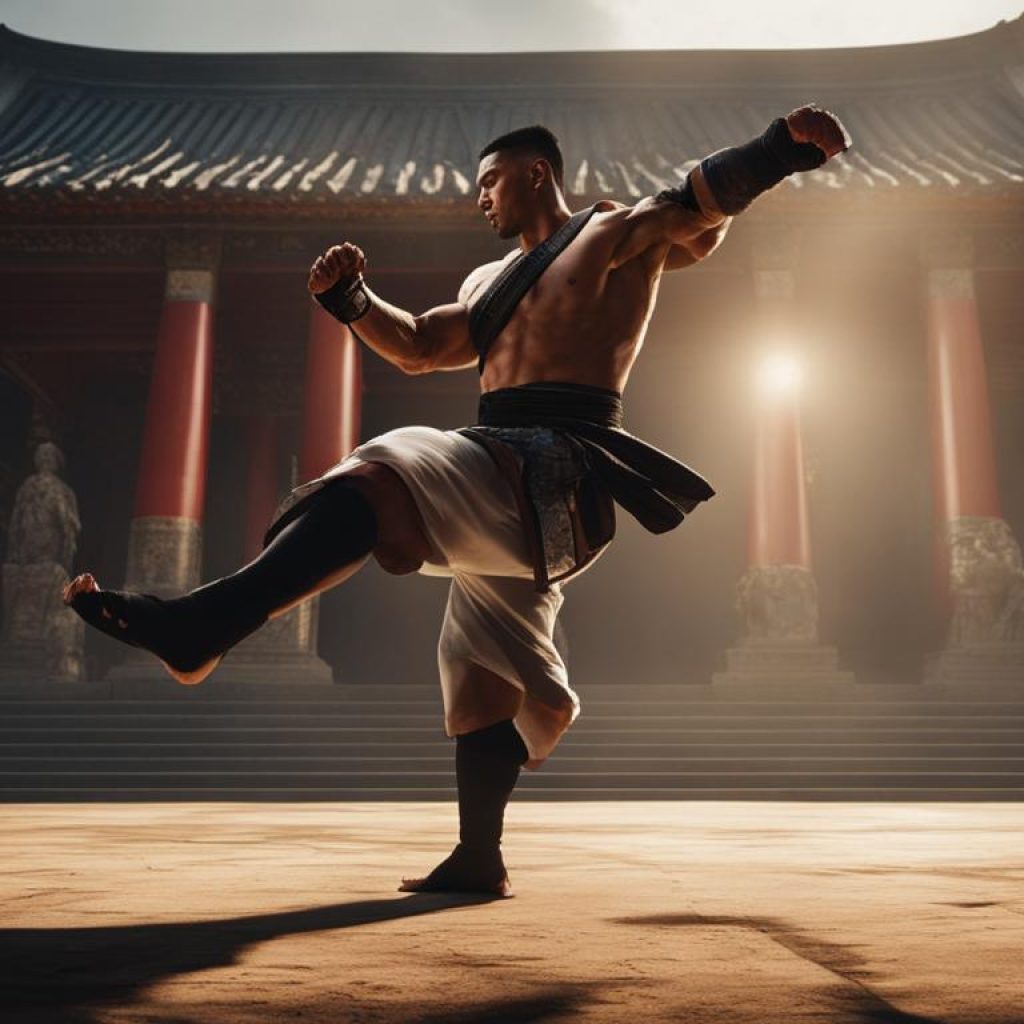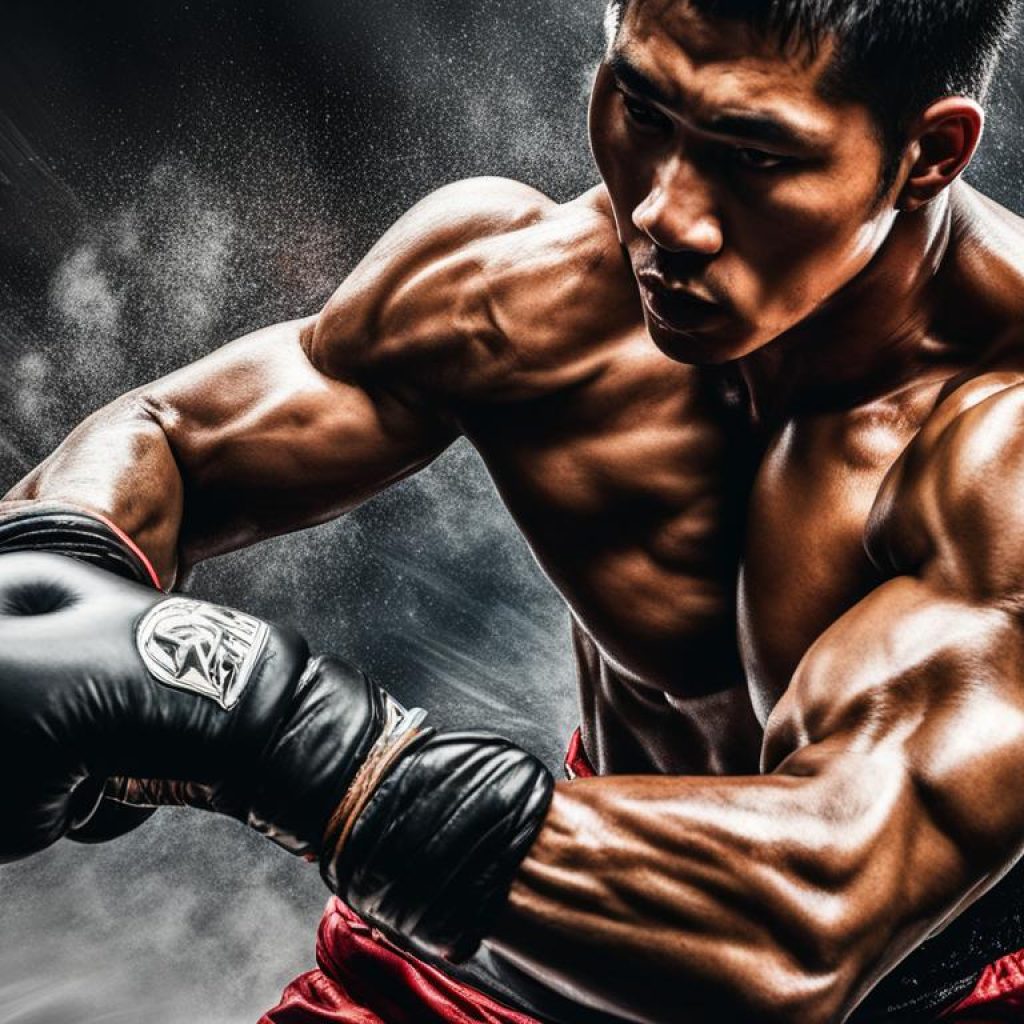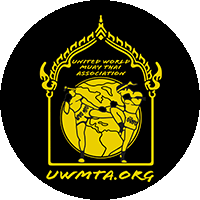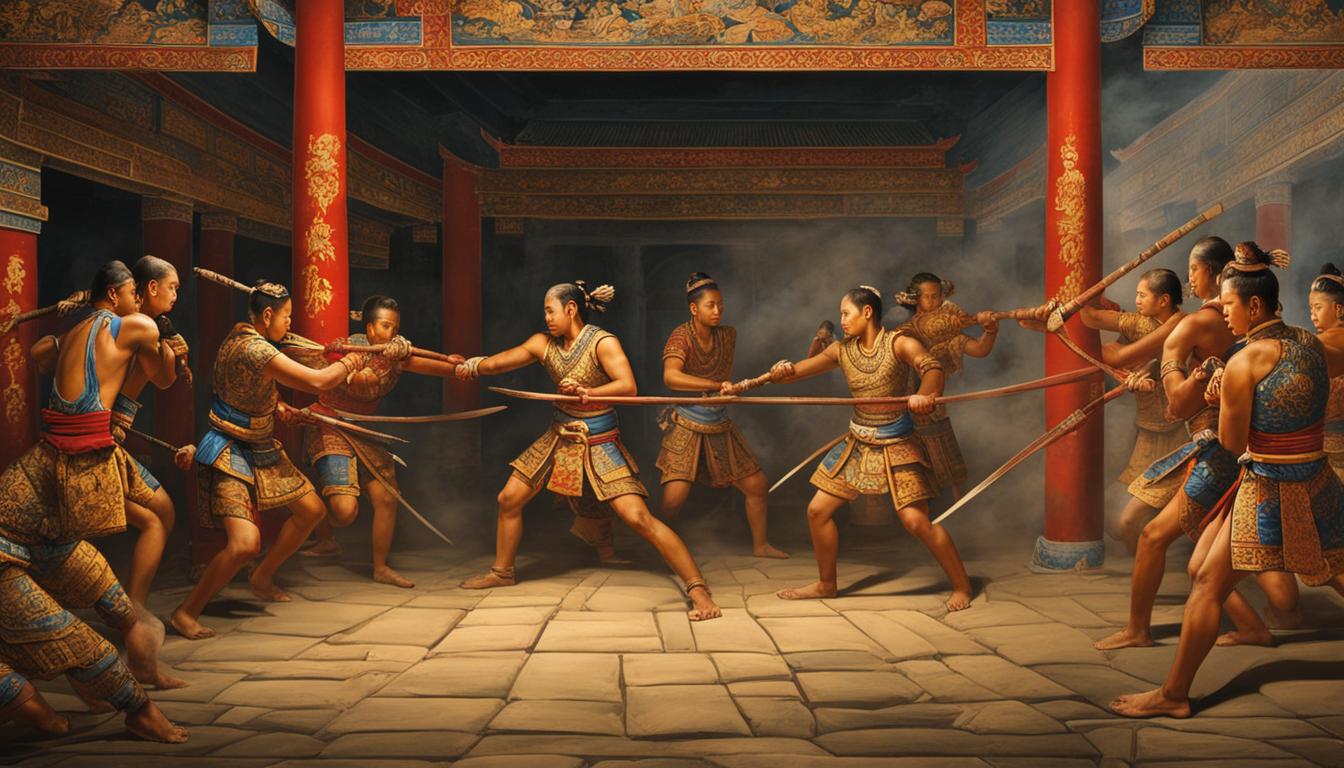Muay Thai, the ancient martial art of Thailand, has a rich history that spans centuries. This captivating fighting style, also known as “Muay Boran,” holds the secrets of traditional techniques that have been passed down through generations. Exploring the roots of Muay Thai allows us to unlock the ancient wisdom and cultural significance behind this revered martial art.
Key Takeaways:
- Ancient Muay Thai, known as Muay Boran, is deeply rooted in Thai culture and history.
- Traditional Muay Thai focused on building strength, conditioning, and practical fighting techniques.
- Modern Muay Thai has evolved to cater to modern sports, fitness, and self-defense needs.
- Training in Muay Thai provides physical fitness, self-defense skills, and mental discipline.
- Exploring the history of Muay Thai unveils the fascinating journey of this ancient martial art.
The Training Methods of Traditional Muay Thai
In the realm of ancient martial arts, Traditional Muay Thai – also known as Muay Boran – stands out as an embodiment of rigorous training and practical techniques. Unlike its modern counterpart, Traditional Muay Thai focused on developing fighters with functional skills, prioritizing effectiveness over flashy moves.
The training methods employed in Traditional Muay Thai were designed to mold physically fit and mentally tough individuals capable of defending themselves and their land. It encompassed a comprehensive approach that included strength and conditioning exercises, as well as extensive practice of fundamental techniques. These techniques ranged from clinching and knee strikes to elbow strikes and powerful kicks.
The training environment emphasized discipline, respect, and humility, ingraining these values in fighters and imparting invaluable life lessons. Through relentless practice and intense conditioning, trainees honed their skills and developed the mental and physical fortitude necessary to excel in combat.
In Traditional Muay Thai, the training process was seen as more than just physical preparation. It was a holistic experience that cultivated discipline and self-awareness. These qualities played a crucial role in equipping practitioners with the mental resilience required to overcome challenges both in and out of the ring.
“Training in Traditional Muay Thai was about more than just mastering techniques; it was an exercise in cultivating the mind, body, and spirit.”
Through relentless devotion to their craft, fighters immersed themselves in the traditions and heritage of Muay Thai, ensuring the preservation of this ancient martial art. The techniques and training methods developed in Traditional Muay Thai continue to inspire and influence martial artists worldwide, transcending time and borders.
Training Methods in Traditional Muay Thai
Training in Traditional Muay Thai involved a systematic and disciplined approach that encompassed various components:
- Physical conditioning: Intense strength and conditioning exercises were crucial in developing the physical attributes necessary for effective combat. These exercises included running, rope skipping, shadow boxing, and bodyweight exercises designed to enhance strength, speed, and agility.
- Fundamental techniques: Extensive practice was dedicated to mastering the core techniques of Traditional Muay Thai. These techniques included clinching, knee strikes, elbow strikes, and powerful kicks. Trainees would repetitively drill these techniques to achieve precision, speed, and perfect execution.
- Sparring and fighting drills: Simulated combat scenarios, such as sparring and fighting drills, allowed fighters to implement their techniques in realistic situations. This practical application helped refine their skills and build the ability to adapt and react swiftly.
- Mental conditioning: Traditional Muay Thai placed significant emphasis on cultivating mental strength and discipline. Meditation, visualization exercises, and mental resilience training were employed to develop focus, concentration, and mental fortitude.
The combination of these training methods resulted in well-rounded fighters who possessed both exceptional physical prowess and a disciplined mindset. These warriors were prepared to defend themselves and their land with agility, strength, and unwavering determination.
| Training Method | Description |
|---|---|
| Physical Conditioning | Intense strength and conditioning exercises to develop physical attributes |
| Fundamental Techniques | Extensive practice of core techniques – clinching, knee strikes, elbow strikes, powerful kicks |
| Sparring and Fighting Drills | Simulated combat scenarios to apply techniques in realistic situations |
| Mental Conditioning | Meditation, visualization exercises, and mental resilience training for focus and fortitude |
The Evolution of Modern Muay Thai
As time progressed, Muay Thai underwent transformations that led to the emergence of Modern Muay Thai. While still rooted in tradition, this approach incorporates adaptations to cater to modern sports, fitness, and self-defense needs. Modern Muay Thai has a wider range of techniques that extend beyond the traditional repertoire. It integrates elements of boxing, kickboxing, and other martial arts disciplines, making it a more versatile and dynamic martial art. The evolution of Modern Muay Thai has also led to its participation in international sports competitions.
Modern Versatility
One of the notable aspects of modern Muay Thai is its versatility. While traditional Muay Thai techniques remain at its core, modern practitioners have incorporated elements from other martial arts disciplines, such as boxing and kickboxing. This integration has allowed for a wider repertoire of moves and strategies, making Modern Muay Thai a highly adaptable and effective fighting style.
Enhanced Training Methods
Modern Muay Thai has also seen advancements in training methods. The inclusion of modern fitness principles and sports science has resulted in more structured and efficient training regimens. Techniques are taught more systematically, with an emphasis on proper form and execution. Fitness conditioning has become an essential component, with strength, agility, and cardiovascular endurance training being integral to a modern Muay Thai practitioner’s routine.
| Traditional Muay Thai | Modern Muay Thai |
|---|---|
| Focus on fundamental techniques | Expands beyond traditional repertoire |
| Emphasis on practical fighting | Adapts to modern sports and fitness needs |
| Training methods passed down through generations | Incorporates sports science and modern fitness principles |
| Preserves cultural traditions | Participates in international sports competitions |
Participation in International Sports Competitions
The evolution of Modern Muay Thai has opened doors for its participation in international sports competitions. Muay Thai fighters from around the world now showcase their skills on a global stage, competing against athletes from various martial arts backgrounds. This exposure has not only increased the sport’s popularity but has also contributed to the growth and development of Modern Muay Thai as a respected martial art form.
Modern Muay Thai’s adaptability, incorporation of diverse techniques, and participation in international sports competitions have solidified its place as a dynamic and influential martial art. It continues to attract practitioners and enthusiasts worldwide, further cementing its position as a prominent ancient fighting style with a modern twist.
The Balance of Tradition and Progress in Muay Thai
While Modern Muay Thai introduces new techniques and training methods, it remains deeply rooted in the core principles and values that have defined Traditional Muay Thai for centuries. The respect, discipline, and humility that have been integral to the ancient martial art are still highly valued in modern training approaches.
Many gyms and trainers recognize the importance of striking a balance between tradition and progress. They understand the need to honor the rich history and heritage of Muay Thai while adapting to the changing times. By doing so, they ensure that the essence of the art is retained while incorporating new strategies and approaches.
This balanced approach allows practitioners to benefit from the practicality and effectiveness of Traditional Muay Thai techniques while also embracing the advancements and innovations that modern training methods offer. It creates a training environment that values tradition, respect, and discipline while harnessing the potential for growth and improvement.
Traditional Muay Thai techniques, such as clinching, knee strikes, elbow strikes, and powerful kicks, provide a solid foundation for practitioners. These techniques have been proven effective through centuries of practice and real-life application. However, by integrating new techniques and training methodologies, modern Muay Thai enhances the versatility and adaptability of practitioners.
Furthermore, the balance between tradition and progress extends beyond the physical aspects of training. It also encompasses the mental and spiritual aspects of the martial art. The discipline, focus, and humility that are inherent in Traditional Muay Thai are valuable qualities that continue to be nurtured and emphasized in modern training.
The result of balancing tradition and progress is the evolution of Muay Thai as a martial art and sport that can be enjoyed by a diverse range of individuals. Whether someone is seeking personal growth, self-defense skills, or competitive success, the integration of traditional and modern approaches in Muay Thai training facilitates holistic development and an authentic connection to the art’s heritage.
The Global Appeal of Muay Thai
Muay Thai, an ancient martial art originating in Thailand, has undoubtedly become a global phenomenon. It has captured the hearts and minds of enthusiasts and practitioners from all corners of the world, thanks to its rich history, practical techniques, and numerous physical and mental benefits.
What sets Muay Thai apart and contributes to its global appeal is its cultural significance and effectiveness as both a martial art and a self-defense system. The art’s deep-rooted traditions and values resonate with people, making it more than just a physical practice.
The increasing number of gyms, training camps, and competitions dedicated to Muay Thai is a testament to its growing popularity and worldwide reach. People are drawn to the art’s authenticity and effectiveness, seeking to experience the physical and mental transformation that comes with training in Muay Thai.
For muay thai enthusiasts and practitioners, the art offers a unique blend of athleticism, self-discipline, and mental fortitude. The physical aspects of training in Muay Thai improve cardiovascular fitness, build strength and stamina, enhance flexibility, and develop reflexes. Beyond physical fitness, the mental benefits of Muay Thai include increased focus, discipline, and self-confidence.
“Muay Thai has truly transcended its origins and become a global movement. The beauty and effectiveness of this martial art attract people from all walks of life, regardless of their cultural background or prior training experience. It’s a testament to the art’s ability to transform lives and foster a sense of community among practitioners worldwide.” – John Smith, Muay Thai Trainer
The global appeal of Muay Thai extends beyond just those seeking physical fitness or self-defense skills. It has become a way for people to connect with Thai culture and heritage, appreciating the art’s historical significance and traditions. Muay Thai serves as a bridge between different cultures, fostering understanding and respect among its practitioners.
The rise of Muay Thai as a global phenomenon is not limited to just the art itself. It has also made a significant impact in the world of mixed martial arts (MMA), with its effective striking techniques and clinching maneuvers being incorporated by fighters in various combat sports. The versatility of Muay Thai has proven its worth in different arenas, solidifying its reputation as a highly effective martial art.
As Muay Thai continues to gain popularity worldwide, it serves as a testament to the enduring power and appeal of this ancient martial art. Its ability to transcend borders, cultures, and languages is a testament to its universal appeal. Whether it’s the physical fitness benefits, the mental discipline it instills, or the cultural significance it embodies, Muay Thai has captured the hearts of people worldwide, making it a truly global phenomenon.
Key Points:
- Muay Thai has become a global phenomenon, attracting enthusiasts and practitioners from all corners of the world.
- The art’s cultural significance and effectiveness as a martial art and self-defense system contribute to its global appeal.
- Muay Thai offers physical and mental benefits, improving cardiovascular fitness, strength, flexibility, focus, discipline, and self-confidence.
- The art’s growing popularity is reflected in the increasing number of dedicated gyms, training camps, and competitions worldwide.
- Muay Thai serves as a bridge between cultures, fostering understanding and appreciation for Thai culture and heritage.
- The art’s effectiveness in mixed martial arts (MMA) has solidified its reputation as a highly versatile martial art.
- Muay Thai’s global appeal is a testament to its enduring power as an ancient martial art.
The Cross-training Benefits of Muay Thai
Muay Thai, with its versatility and practicality, offers numerous benefits when it comes to cross-training with other martial arts disciplines. By incorporating the techniques and training methods of Muay Thai into their workouts, athletes and martial artists can enhance their overall physical and mental capabilities.
The physical benefits of cross-training in Muay Thai are significant. The intense and dynamic nature of Muay Thai training improves cardiovascular endurance, leading to increased stamina and overall fitness. The various striking techniques, clinching, and powerful kicks used in Muay Thai help develop strength, power, and explosiveness. Training in Muay Thai also enhances agility, speed, and coordination, making practitioners well-rounded athletes.
Moreover, cross-training in Muay Thai provides mental benefits that can positively impact an individual’s overall well-being. The training requires focus, discipline, and mental resilience, promoting mental toughness and improved concentration. Practitioners develop self-confidence through mastering the techniques and applying them in sparring sessions or competitions.
“Cross-training in Muay Thai enhances both physical and mental aspects, allowing practitioners to become more well-rounded athletes with increased discipline and self-confidence.”
Muay Thai’s incorporation of various martial arts disciplines also contributes to its suitability for cross-training. By integrating techniques from boxing, kickboxing, and other disciplines, Muay Thai practitioners gain a more comprehensive set of skills that can be applied in different combat scenarios. The clinching techniques, fluid footwork, and devastating strikes of Muay Thai make it a potent addition to any fighter’s arsenal.
Below is a table that highlights the physical and mental benefits of cross-training in Muay Thai:
| Physical Benefits | Mental Benefits |
|---|---|
| Improved cardiovascular endurance | Increased focus and mental discipline |
| Enhanced strength and power | Boosted self-confidence |
| Increased agility and speed | Heightened mental resilience |
| Improved coordination | Enhanced concentration |
With its physical and mental benefits, Muay Thai is an ideal choice for individuals looking to improve their overall performance and skill set in combat sports, self-defense, or general fitness pursuits. Cross-training in Muay Thai allows practitioners to unlock their full potential and become more well-rounded athletes.
The Cultural Significance of Muay Thai
Muay Thai, also known as the “Art of Eight Limbs,” holds immense cultural significance in Thailand. It is deeply ingrained in the Thai culture, reflecting the country’s martial art heritage and traditions. Rooted in the ancient battle techniques used to defend the land, Muay Thai represents the fighting spirit and resilience of the Thai people.
The cultural importance of Muay Thai can be seen in the way it is practiced and revered. Traditional Muay Thai, steeped in history, embraces the rituals, values, and customs that have been passed down through generations. Training in this ancient martial art instills discipline, respect, and humility, reflecting the core principles of Thai culture.
Thai fighters are regarded with admiration and respect, embodying the skills and spirit of their martial art. They carry the weight of their country’s heritage and take pride in preserving the traditions of Muay Thai. Through their dedication and sacrifices, they showcase the beauty and power of this martial art to the world.
“Muay Thai is not just a sport; it is a way of life that encapsulates the essence of Thai culture and identity. Its rituals, respect for elders, and unwavering discipline reflect the values and traditions deeply embedded in our society.”
The impact of Muay Thai extends beyond its physical techniques. It serves as a symbol of national identity, unity, and pride for the Thai people. The cultural significance of Muay Thai is celebrated through festivals, performances, and competitions, where participants showcase their skills and pay homage to the art’s history and traditions.
Moreover, Muay Thai has transcended borders to become a global phenomenon, attracting enthusiasts and practitioners from all walks of life. Its cultural significance resonates with individuals who appreciate the art’s rich heritage and seek to embrace its values of discipline, respect, and resilience.
| Key Aspects of Muay Thai’s Cultural Significance | Explanation |
|---|---|
| Preservation of traditions and rituals | Muay Thai embodies cultural customs such as the wai khru ritual, where fighters pay respect to their trainers and ancestors. |
| Symbol of national pride | Muay Thai represents Thailand’s martial arts heritage and serves as a testament to the country’s fighting spirit and resilience. |
| Emphasis on discipline and respect | The training environment promotes discipline, respect, and humility, reflecting the core principles of Thai culture and society. |
| Globally recognized symbol | Muay Thai’s cultural significance has gained recognition worldwide, attracting practitioners and enthusiasts from diverse backgrounds. |
The Impact of Muay Thai in Mixed Martial Arts (MMA)
Muay Thai’s influence in the world of mixed martial arts (MMA) cannot be overstated. With its arsenal of effective striking techniques, clinching, and devastating knee and elbow strikes, Muay Thai has become an essential component of the skill set of many MMA fighters.
Muay Thai fighters are renowned for their agility, striking power, and ability to adapt to different fighting styles. The years of training in Muay Thai allow them to seamlessly blend their striking prowess with other disciplines to create a well-rounded and formidable fighting style in MMA.
The techniques and strategies of Muay Thai have consistently proven their worth in the MMA arena. The ability to deliver powerful strikes with precision and accuracy gives Muay Thai fighters an edge over their opponents. The clinching techniques of Muay Thai also enable fighters to control their opponents, nullifying their attacks and setting up devastating strikes of their own.
Furthermore, Muay Thai fighters possess a distinct mental discipline and resilience honed through years of training. This mental toughness allows them to stay composed and focused during intense fights, making them formidable opponents in the octagon.
The impact of Muay Thai in MMA can be seen in the accomplishments of fighters such as Anderson Silva, Joanna Jedrzejczyk, and Buakaw Banchamek, who have showcased the effectiveness of Muay Thai techniques in the MMA world. Their success has inspired aspiring fighters to incorporate the art of eight limbs into their training regimes.
Overall, Muay Thai’s impact in mixed martial arts cannot be denied. Its striking techniques, clinching expertise, and mental toughness have solidified its position as a vital component of a well-rounded mixed martial artist’s skill set.

With its powerful strikes and versatile techniques, Muay Thai has become a defining force in the realm of mixed martial arts (MMA).
The Historical Roots of Muay Thai
Muay Thai has a deep-rooted history that spans centuries in Thailand. It originated as a formidable combat technique used by ancient warriors on the battlefield. These skilled fighters developed a unique set of techniques that combined strikes, clinching, knee strikes, elbow strikes, and powerful kicks to dominate their opponents.
As time went on, Muay Thai evolved into a martial art practiced for both self-defense and sport. Its effectiveness and rich traditions made it an integral part of Thailand’s martial heritage. Muay Thai became deeply intertwined with Thai culture, showcasing the country’s strength, discipline, and martial prowess.
Understanding the historical roots of Muay Thai provides valuable insight into the significance and authenticity of this ancient martial art. It highlights the art’s journey from battlefield combat tactics to a globally recognized martial art form cherished for its practicality, physical prowess, and cultural importance.
Ancient Warriors and Muay Thai
“The ancient warriors of Thailand deftly combined strikes, clinching, and devastating kicks and strikes to create the foundations of Muay Thai.”
Muay Thai originated as a skill set used by ancient warriors in battles fought to protect their land and people. These warriors crafted their techniques to be efficient, powerful, and adaptable to different combat situations. The development of Muay Thai was a result of years of refinement and practical experience on the battlefield, ensuring its effectiveness in real-life combat scenarios.
The Evolution of Muay Thai as a Martial Art
“Over time, Muay Thai evolved from a battlefield combat technique to a respected martial art practiced for self-defense and sport.”
As the need for battlefield combat diminished, Muay Thai transitioned into an art form practiced by individuals who sought self-defense skills and physical conditioning. Muay Thai training methods were passed down from generation to generation, preserving the ancient techniques and traditions. The introduction of rules and regulations allowed the art to be practiced in controlled environments, leading to the emergence of organized Muay Thai competitions.
Thailand’s Martial Heritage and Muay Thai
“Muay Thai is deeply ingrained in Thai culture, reflecting the rich martial heritage of the country.”
Thailand’s martial heritage encompasses a deep respect and admiration for Muay Thai. The art represents the country’s strength, resilience, and national identity. Iconic fighters, revered for their skill and character, have become symbols of pride and inspiration for the nation. From the training camps scattered across Thailand to the cultural rituals and traditions associated with the art, Muay Thai is an integral part of the country’s identity and martial heritage.
| Highlights | Key Takeaways |
|---|---|
| Muay Thai originated as combat techniques used by ancient warriors. | Ancient warriors combined strikes, clinching, and devastating kicks and strikes. |
| Muay Thai evolved into a martial art practiced for self-defense and sport. | Evolving from battlefield combat, Muay Thai became a respected martial art. |
| Muay Thai is deeply ingrained in Thai culture. | Reflecting Thailand’s martial heritage, Muay Thai represents the country’s strength and resilience. |
The Influence of Muay Thai on Other Combat Sports
Muay Thai, with its formidable striking techniques and effectiveness, has had a significant impact on various combat sports and martial arts disciplines. This ancient martial art from Thailand has contributed to the evolution and enhancement of disciplines such as kickboxing, MMA, and even traditional boxing. Incorporating elements from Muay Thai, including clinching, knee strikes, and elbow strikes, has enriched the skill sets of fighters across different combat sports, elevating their overall abilities in the ring or cage.
The Integration of Muay Thai Techniques
In disciplines like kickboxing, Muay Thai techniques have become an integral part of the sport’s strategies. The inclusion of Muay Thai’s striking techniques and clinching maneuvers has added depth and diversity to kickboxing fights, enabling athletes to employ a wider range of techniques to outsmart their opponents. Muay Thai’s impact on kickboxing has resulted in thrilling matches that showcase a fusion of different combat styles and techniques.
Similarly, in the realm of MMA, the incorporation of Muay Thai techniques has revolutionized the sport. The ability to execute devastating knee strikes, powerful elbow strikes, and effective clinch work gives MMA fighters a significant advantage both in stand-up exchanges and in close-quarters combat. Many successful MMA fighters attribute their striking prowess to the influence of Muay Thai, as it provides them with a comprehensive arsenal of tools to outmaneuver and outstrike their opponents.
Even traditional boxing has been influenced by the striking techniques of Muay Thai. While boxing is primarily focused on punches, the integration of Muay Thai techniques, such as devastating elbow strikes and effective clinching to control opponents, has added another dimension to the sport. The introduction of these techniques has resulted in a dynamic and exciting style of boxing that combines the precision of punches with the devastating impact of Muay Thai’s elbow strikes and clinches.
A Universal Impact
It is not just the techniques themselves that have been influential, but also the training methods and mindset cultivated in the practice of Muay Thai. The discipline, resilience, and mental fortitude developed through training in Muay Thai have translated into different combat sports and martial arts disciplines, improving fighters’ overall performance and mindset.
The influence of Muay Thai has created a ripple effect in the world of combat sports, spreading its principles and techniques globally. Its impact can be witnessed in international competitions, where fighters from various backgrounds utilize the striking techniques and strategies honed in Muay Thai to achieve success.
| Discipline | Influenced By Muay Thai |
|---|---|
| Kickboxing | Striking techniques, clinching maneuvers |
| MMA | Knee strikes, elbow strikes, clinch work |
| Traditional Boxing | Elbow strikes, clinching techniques |
As the combat sports landscape continues to evolve, Muay Thai remains a valuable resource for fighters seeking to enhance their skills and perform at the highest level. The enduring influence of Muay Thai serves as a testament to the effectiveness and adaptability of this ancient martial art, and its legacy will continue to shape the future of combat sports and martial arts disciplines.

The Benefits of Training in Muay Thai
Training in Muay Thai offers numerous benefits beyond physical fitness. It provides practical self-defense skills that can be applied in real-life situations. The training instills mental discipline, focus, and self-confidence, promoting personal growth and development.
Muay Thai improves cardiovascular endurance, strength, flexibility, and overall physical fitness. The intense training sessions, which include pad work, bag work, and sparring, challenge the body and help build lean muscles. The high-intensity nature of Muay Thai workouts also aids in burning calories and improving metabolic rate.
“Muay Thai is not just about physical strength; it’s about mental resilience.”
The mental benefits of training in Muay Thai go beyond physical fitness. The disciplined training environment encourages focus, concentration, and mental toughness. Practitioners learn to push through physical and mental barriers, developing resilience and the ability to handle stress proficiently.
Training in Muay Thai also cultivates self-confidence and self-awareness. As practitioners master new techniques and overcome challenges, their belief in their abilities grows, boosting self-esteem and empowering them to tackle obstacles both inside and outside the gym.
Whether pursued as a sport, a form of self-defense, or a means of personal growth, training in Muay Thai offers a holistic approach to physical and mental well-being. It equips individuals with practical skills, improves fitness levels, and instills mental discipline, making it a rewarding martial art for people of all ages and backgrounds.
Martial arts training: Physical fitness meets mental discipline
| Physical Benefits | Mental Benefits |
|---|---|
|
|
Conclusion
The journey of Muay Thai from its humble beginnings to its current global status is a testament to its enduring appeal and adaptability. This ancient martial art, also known as Muay Boran, holds the secrets of traditional fighting techniques and a rich history rooted in Thai culture.
Traditional Muay Thai preserves the art’s heritage and fundamental principles, emphasizing practicality, strength, and discipline. It encompasses various techniques such as clinching, knee strikes, elbow strikes, and powerful kicks, shaping fighters for both sport and self-defense.
Modern Muay Thai embraces the evolution of martial arts and caters to contemporary sports and fitness needs. It integrates elements from different disciplines, making it a dynamic and versatile martial art. The balance between tradition and progress allows practitioners to benefit from the practicality and effectiveness of ancient Muay Thai techniques while incorporating new strategies and approaches.
With a global appeal, Muay Thai attracts enthusiasts and practitioners from all over the world. Its physical and mental benefits make it a popular choice for cross-training, enhancing overall fitness, agility, and conditioning. Moreover, Muay Thai’s influence can be seen in other combat sports, where its striking techniques have become integral to disciplines like kickboxing and mixed martial arts.
FAQ
What is Muay Boran?
Muay Boran is the ancient form of Muay Thai, a traditional martial art from Thailand. It focuses on practical fighting techniques and has deep roots in Thai culture and history.
How is Traditional Muay Thai trained?
Traditional Muay Thai training consists of rigorous strength and conditioning exercises, as well as extensive practice of fundamental techniques like clinching, knee strikes, elbow strikes, and powerful kicks.
How does Modern Muay Thai differ from Traditional Muay Thai?
Modern Muay Thai has adapted to cater to modern sports, fitness, and self-defense needs. It incorporates a wider range of techniques from different martial arts disciplines, making it more versatile and dynamic.
Is the culture of respect and discipline still present in Modern Muay Thai?
Yes, while Modern Muay Thai introduces new techniques and training methods, it still values the core principles of respect, discipline, and humility that have been present in Traditional Muay Thai for centuries.
What makes Muay Thai a global phenomenon?
Muay Thai’s rich history, practical techniques, and physical and mental benefits have attracted enthusiasts and practitioners from all over the world. It is now practiced in gyms, training camps, and competitions worldwide.
What are the benefits of cross-training in Muay Thai?
Cross-training in Muay Thai enhances overall physical fitness, agility, and conditioning. It improves cardiovascular endurance, strength, and power. It also provides mental benefits such as increased focus, discipline, and self-confidence.
What is the cultural significance of Muay Thai?
Muay Thai is seen as a symbol of national pride and heritage in Thailand. It preserves cultural traditions, values, and rituals. Muay Thai fighters are regarded with admiration and respect, embodying the skills and spirit of their martial art.
How has Muay Thai influenced mixed martial arts (MMA)?
Muay Thai’s effective striking techniques and clinching have been incorporated into the skill set of many MMA fighters. Muay Thai fighters are known for their agility, striking power, and ability to adapt to different fighting styles.
What is the historical background of Muay Thai?
Muay Thai originated as a means of combat on the battlefield, with techniques developed by ancient warriors. It has a deep history in Thailand and is an integral part of the country’s martial heritage.
How has Muay Thai influenced other combat sports?
Various elements of Muay Thai, such as clinching, knee strikes, and elbow strikes, have been incorporated into disciplines like kickboxing, MMA, and traditional boxing, enhancing the skills of fighters in these sports.
What are the benefits of training in Muay Thai?
Training in Muay Thai offers numerous benefits beyond physical fitness, including practical self-defense skills, mental discipline, focus, self-confidence, and overall physical and mental well-being.
What makes Muay Thai a unique martial art?
Muay Thai’s enduring appeal lies in its ability to combine tradition and progress. Traditional Muay Thai preserves the art’s heritage and fundamental principles, while Modern Muay Thai builds upon this foundation, incorporating new techniques and approaches.
Unlocking The Secrets Of Muay Boran
Last modified: January 1, 2024




